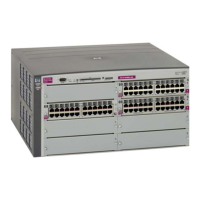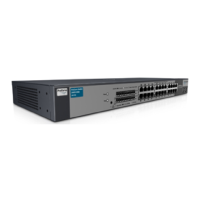High availability 148
Assigning VRRP virtual router ID
During the software upgrade process, VRRP virtual router IDs are assigned automatically if failover is enabled on the
switch. When configuring virtual routers at any point after upgrade, virtual router ID numbers
(/cfg/l3/vrrp/vr #/vrid) must be assigned. The virtual router ID may be configured as any number between 1
and 255.
Configuring the switch for tracking
Tracking configuration largely depends on user preferences and network environment. Consider the configuration
shown in the previous figure. Assume the following behavior on the network:
• Switch A is the master router upon initialization.
• If Switch A is the master and it has one fewer active servers than Switch B, then Switch A remains the master.
• This behavior is preferred because running one server down is less disruptive than bringing a new master online
and severing all active connections in the process.
• If Switch A is the master and it has two or more active servers fewer than Switch B, then Switch B becomes the
master.
• If Switch B is the master, it remains the master even if servers are restored on Switch A such that it has one
fewer or an equal number of servers.
• If Switch B is the master and it has one active server fewer than Switch A, then Switch A becomes the master.
The user can implement this behavior by configuring the switch for tracking as follows:
1. Set the priority for Switch A to 101.
2. Leave the priority for Switch B at the default value of 100.
3. On both switches, enable tracking based on ports (ports), interfaces (ifs), or virtual routers (vr). You can
choose any combination of tracking parameters, based on your network configuration.
NOTE: There is no shortcut to setting tracking parameters. The goals must first be set and the outcomes of
various configurations and scenarios analyzed to find settings that meet the goals.
High availability configurations
GbE2c Ethernet Blade Switches offer flexibility in implementing redundant configurations. This section discusses the
Active-Active configuration.
Active-Active configuration
The following figure shows an example configuration, where two switches are used as VRRP routers in an active-
active configuration. In this configuration, both switches respond to packets.
Figure 27 Active-Active high availability configuration
Although this example shows only two switches, there is no limit on the number of switches used in a redundant
configuration. It is possible to implement an active-active configuration across all the VRRP-capable switches in a LAN.
Each VRRP-capable switch in an active-active configuration is autonomous. Switches in a virtual router need not be
identically configured.
In the scenario illustrated in the figure, traffic destined for IP address 10.0.1.1 is forwarded through the Layer 2
switch at the top of the drawing, and ingresses Switch A on port 20. Return traffic uses default gateway 1
(192.168.1.1). If the link between Switch A and the Layer 2 switch fails, Switch B becomes the Master because it has
